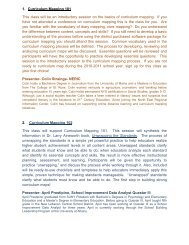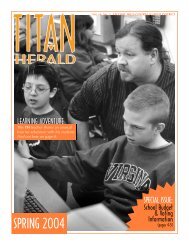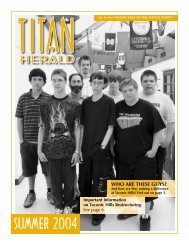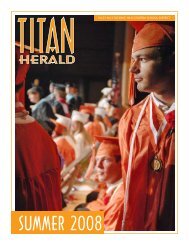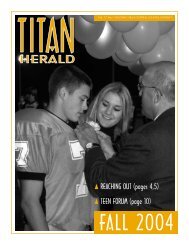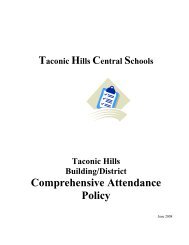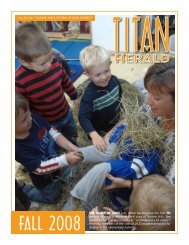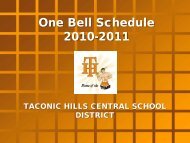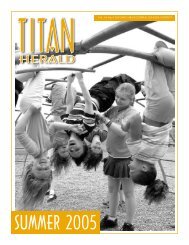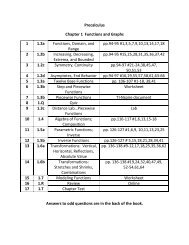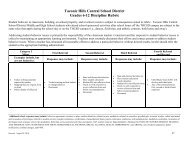Spring 2005 - Taconic Hills Central School District
Spring 2005 - Taconic Hills Central School District
Spring 2005 - Taconic Hills Central School District
Create successful ePaper yourself
Turn your PDF publications into a flip-book with our unique Google optimized e-Paper software.
Vol. 18 No.3 TACONIC HILLS CENTRAL SCHOOL DISTRICT▲ Special Issue:<strong>School</strong> Budget& VotingInformationSPRING <strong>2005</strong>
MORNING PROGRAM:STARTING THE WEEK ON THE RIGHT FOOTEvery Monday morning, TH school students in grades K-2 gather in thePerforming Arts Center to kick off the new week. At the same time, theyoften meet such morning program guests as Copake Town SupervisorAngelo Valentino, who came on Election Day, and the Cat in the Hat, whomagically appeared on the birthday of Dr. Seuss.“The morning program is a tradition here,” TH Elementary PrincipalAnthony Marchesano said. “It’s a teaching tool and a way to foster community.”Special morning programs address specific issues young students face,from dressing warm in winter to preparing for a trip to the dentist.A team of TH teachers, staff and parents makes morningprogram go. Judy Krom, Jennifer Chase, Ellen Rocco, TaraDunspaugh and Colleen Miller have been supported by parentvolunteers Sarah Montague and Doreen Weisner.The team assembles a group of K-2 students once a week.The students each play a role in the program, from holding theflag and leading the pledge to giving a morning weather report,posing a riddle, and soliciting answers from the audience with amicrophone. Birthdays are acknowledged. Students also greetvisitors at the door.Parents, grandparents and friends are encouraged to comecheck out morning program for themselves. It happens at 9:10every Monday morning. ▲SUNY STUDY BRINGS READING PROS TO TACONIC HILLSQuietly over the past two years,a team of highly trained,experienced teachers has beenworking at <strong>Taconic</strong> <strong>Hills</strong>, helping studentsin grades K-1 learn the most fundamentalskills they need to becomegood readers. The program is part of afederally funded research project called“Preventing Reading Difficulties.” Theproject, designed by the Child Researchand Study Center at the University atAlbany, State University of New York,seeks to gather additional evidence ofthe effectiveness of specific teachingmethods upon improving literacy skillsin young children who have been identifiedas “at-risk” for reading difficulties.“Studies have shown that studentswho are behind their peers at the endof 1st grade are likely to have readingproblems throughout school,” PrincipalAnthony Marchesano said. “The benefitof this project for us is that it isbringing in extra instructors who meetwith students in groups of two or threeat no cost to the district.”Mr. Marchesano said that while thegoal of the study is to gather informationfor broad use in public education,<strong>Taconic</strong> <strong>Hills</strong>’ participation in the projectis having a dramatic effect.“We began active participation inthe study in 2003. That year, in the fallassessments of incoming kindergartenstudents, there were between 35 and40 kindergarten students deemed atrisk of not reading well. In that samegroup today, the number is down to 15,”he said.The study assesses incoming kindergartenstudents whose parents agree totheir children’s involvement and identi-Continued on page 73
Proposed <strong>2005</strong>–2006 <strong>School</strong> Budget<strong>Taconic</strong> <strong>Hills</strong> <strong>Central</strong> <strong>School</strong> <strong>District</strong> Budget ComparisonBUDGET 2004/<strong>2005</strong> <strong>2005</strong>/2006General Support 3,193,602 3,378,515 Administrative costs, insurance,building maintenance and operation.Instructional 12,950,912 13,590,902 Teacher salaries, aide salaries, textbooksand supplies, special education programs,vocational education, athletics, computersand library costs.Transportation 1,762,261 1,803,555 Bus driver salaries, bus maintenance, fuel,garage expenses, insurance and contracting.Community Service 62,431 188,026 Census and attendance tracking, communityevents and building use.Employer Contributions 6,295,465 7,047,026 Employee health insurance, social security,workers’ compensation and retirement plans.Debt Service 2,958,848 2,964,964 Includes debt for central schoolconstruction.Total Budget 27,223,519 28,972,988 $Change: 1,749,469 %Change: 6.43%REVENUE SOURCEState Aid 8,962,857 9,751,053 Includes revenues paid directly to the schoolfor operational, building and special purposecosts.Other Sources 1,407,965 1,411,465 Interest earnings, admissions to events,tuition, annual refund from BOCES and transferfrom building sale and debt reserve fund.Fund Balance 725,000 725,000 Allocation of 2004/<strong>2005</strong> resources.Tax Levy 16,127,697 17,085,470 $Change: 957,773 %Change: 5.94%Total Revenues 27,223,519 28,972,988 $Change: 1,749,469 %Change: 6.43%4PROPOSITION 1<strong>2005</strong>-2006 BUDGETShall the following proposition be adopted, to wit:RESOLVED, that the budget for the school year<strong>2005</strong>–2006 for the <strong>Taconic</strong> <strong>Hills</strong> <strong>Central</strong> <strong>School</strong><strong>District</strong> at Craryville, Columbia and Dutchess Counties,New York in the amount of $28,972,988 be adoptedand the Board of Education be further authorized toraise such portion thereof as may be necessary by taxlevied on the taxable property of said school district.▲PROPOSITION 2BUS PURCHASEShall the following proposition be adopted, to wit:RESOLVED, that the Board of Education of the<strong>Taconic</strong> <strong>Hills</strong> <strong>Central</strong> <strong>School</strong> <strong>District</strong> at Craryville ishereby authorized to (a) acquire school buses, at amaximum aggregate cost of $190,000 (b) expend suchsums for the purpose; (c) expend from the 2003 BusPurchase Reserve Fund an amount not to exceed$190,000 for such purpose; (d) levy the necessary tax
▲ ▲ ▲▲PROPOSED BUDGET <strong>2005</strong>/2006Debt Service$2,964,964 10%CommunityService$188,026 1%therefor, to be levied and collected in such amounts asmay be determined by the Board of Education takinginto account state aid received and amounts disbursedfrom the reserve fund; and (e) in anticipationof the collection of such tax, to issue bonds and notesof the <strong>District</strong> at one time or from time to time in theprincipal amounts not to exceed $190,000, and to levy atax to pay the interest on such obligations when due. ▲Questions and AnswersHow does the proposed school budget for <strong>2005</strong>–2006compare to the current year’s budget?Primarily due to the increased costs of health insurance andboth retirement systems, the proposed budget reflects anincrease of 6.43 percent. In the worst case scenario, the taxlevy for this proposed budget would increase by 5.94 percent.Will the tax levy change?EmployeeBenefits$7,047,02624%Transportation $1,803,555 6%Instructionaland GeneralSupport$16,969,41759%We believe the answer is “yes.” By August, the districtshould have a more firm understanding of any increase instate aid. As in the past, the Board of Education has usedadditional state aid to lower the tax levy, and it plans to dothis once again this year. First, the board must be sure ofexactly how much new aid will be realized by the district.What are the costs that are mandated upon the districtfrom outside sources that cannot be controlled locally?The district has been told to plan for a health insurancecost increase of 15.5 percent. When this mandated increasewas added to the additional cost increases of the TeachersRetirement System and Employees Retirement System, atotal increase of $736,290 had to be reflected in the proposedbudget.What about the costs the district can control?We have tried to control our own costs of supplies, equipment,staffing and maintenance. In fact, we are proposing areduction in administration, and the transportation departmentreflects only a 2.34 percent increase. It has been theoutside factors that have impacted us the most for next year.VOTE May 17, <strong>2005</strong>WHERE: Veterans Community RoomWHEN: 12 noon to 9 p.mREGISTRATION DATE: May 5, 12 noon to 8 p.m.▲ ▲ ▲ ▲What cuts and additions are being proposed in the<strong>2005</strong>–2006 budget?The proposed budget removes the position of director oftechnology, cuts a half-time psychologist position, abolishesthe position of assistant superintendent and reduces it to alower paying position to address testing and student performance.Also, the Middle <strong>School</strong> dean position was not added.In recognition of the need to address class size, this proposedbudget adds a full time English/reading position andfunds for two part-time teaching positions in mathematicsand social studies. Also, it maintains the lower elementaryclass size levels.Are there any educational programs being removed fromthe proposed budget?There are no intentions to reduce any academic programsfor next year.What about the building repairs?There are no new expenses reflected in the proposed budgetfor any repairs to the building. The district has workedhard toward not paying more for a project that was alreadypaid in full. The cooperation of most of the original contractorshas been exemplary.What should I do if I have any other questions?You are encouraged to attend any Board of Education meeting.Every meeting is open to the general public. Also, youmay call any Board of Education member since each is amember of the school community. You may call or write tothe offices of the district’s school business official or thesuperintendent. Their names and phone numbers are listedin all district publications as well as on the district’s website.$19.00$18.00$17.00$16.00$15.00$14.00$13.00$12.00$11.00$10.00Average Tax Rate per $1,000of Assessed Value over Ten Townships$15.7097/98$16.3998/99$16.9599/00$16.9400/01$16.3201/02$15.9402/03$14.3703/04$12.8104/055
A DAY IN THE LIFE OF…<strong>School</strong> Business Official MARY GRDEN6On May 17, the <strong>Taconic</strong> <strong>Hills</strong> community will voteon the district’s annual budget. Along withSuperintendent David Paciencia, the assistantsuperintendent, the principals and the board of education,TH <strong>School</strong> Business Official Mary Grden has been workinglong hours putting together the 05–06 budget. The fruits ofher labor can be found on page four of this issue. A littlemore about the person can be found here.At <strong>Taconic</strong> <strong>Hills</strong>, Mrs. Grden oversees the businessoffice, the building and grounds department, other schoolsupport staff, the transportation department, the cafeteriaservices department and the public use of the aquatic center.At the same time, she carries around in her head anenormous network of numbers: how much things cost,what expenditures need to be increased, changes in stateand federal aid and ways that the district can be savingmoney.The school budget, she explains, is a complicated functionof constantly moving figures. Many budget projections needto be made well inadvance of actualincome. State aid mayrise or be cut. Federalfunding may increase ordecrease. More or fewerstudents may show upfor a school year or for a particular program. And the taxlevy between communities is constantly changing based onproperty values and equalization rates.“The finances of a school district are so complex andfluid that people think you’re not being truthful,” she says.“The truth is, we are always working on the budget, 12months a year. At this time of year, my job is to have thefigures ready, understandable and accurate, so the communitycan review them.”Sometimes people are unhappy. Does it bother her whenshe receives criticism?“Sure, it does bother me. Even though I always try to domy absolute best for the district, I know criticism isinevitable. Not everyone is going to understand. And noone likes to pay more taxes. I get calls. And I know peoplecan hold on to issues for a long time. But I personally can’tlive like that.”She knows how she can live. She has looked directly at thealternative. At 42, she was diagnosed with malignant breastcancer. At the time, her mother was dying of breast cancerand her older sister soon would die of it, too. This was aturning point in a life that began in a working class family ina suburb north of Buffalo, New York.“My mother always expected a lot out of me,” sheremembers. “I was taught to strive and always do my best,but no one thought I would go to college.” Or get a jobmanaging a school district business office and overseeing astaff of nearly 145 people. And nothing in her family backgroundcould explain this thing about horses.“When I look back, I see that this part of me was alwaysthere, from the very beginning. As a child I was on myrocking horse. I had stuffed horses. An inflatable horse forthe pool. I’m obsessed with horses. I admit it. It’s alwaysbeen a passion of mine.”She remembers her father, a factory worker, taking herto a fair grounds so she could ride every Saturday morning.Saturday became Saturday and Sunday. Saturday andSunday became Saturday, Sunday and Monday. “Thenmy parents said ‘enough.’ I never had a formal lesson.And I never had a horse. When I was pregnant I’d go to thedoctor’s office. OtherBuilding the budget is a team effortinvolving the entire board, the superintendent,the assistant superintendent, the principalsand the school business official.expectant mothers werereading parenting magazines.I was reading“Horse and Rider.”In high school, shewent to work for asmall company in which she did everything from bookkeepingto unloading boxes. She went to night school to pursuea college degree and was hired as a secretary to the businessofficial for the Randolph <strong>Central</strong> <strong>School</strong> <strong>District</strong>. Sixmonths later, the business official left and she was promotedto his job. She came to <strong>Taconic</strong> <strong>Hills</strong> five years later. Shestill didn’t own a horse.When she was diagnosed with cancer, her husbandbought Mary her first horse.“I thought to myself: I can’t die now that I’ve finallygotten a horse.”With her horse and family to live for—her first grandchildhad just been born—she became a cancer patient andthen a cancer survivor. For a woman adept at dollars andcents, there’s no way to calculate the value of every singleday of her life.“Yes, I’ve had cancer. But with a job I love, a husbandwhose support and understanding has sustained me, withmy family and my horses—it all feels like the best life aperson could ever have.”Every day at <strong>Taconic</strong> <strong>Hills</strong>, someone comes to her seeking
help with a problem. A special education teacher may run intoan unexpected need for a student. A classroom directly in thesun may need some kind of air circulation unit. At momentslike this, her knowledge of the district’s finances and her abilityto work with people come together.“I like dealing with the dollars and cents, but I like dealingwith people just as much,” she says. “I love helping people.Even if I can’t give someone the answer they want, I canhelp by giving every issue my energy, by looking for creativeways to find an answer.”She finds that people often come to her overwhelmed byan issue. “I’m always sitting down and brainstorming. Whatcan we do to fix this problem? Sometimes it involves moneybut usually it involves making some kind of change, seeinganother solution. I try to be honest, clear and positive.”She singles out herimmediate staff in thebusiness office forspecial praise.“They’re the best.They’re like family.When someone issick, they are the firstones to show up withfood or other help.Without them theschool wouldn’t bewhere it is and Icouldn’t do what Ido. We can be proudof our service to theschool and the communityand of thefact that we’ve hadclean audits here.”She takes great joy in visiting and being visited by her son,daughter and six grandchildren. When they come to theirgrandmother’s house in Columbia County, the children knowthey are going to run and roam and ride horses, to sit bycampfires and take tractor rides. And they know that theirgrandmother is not only riding horses herself, but beginningto try out dressage and horse jumping.Her boss, Superintendent David Paciencia, and herchildren, both think that jumping at her age is a bit much.“They say, ‘Mary, you’ll break your neck.’ My husbanddoesn’t even bother anymore. He knows that I’ll just laugh.After what I’ve been through, if I die riding a horse I’ll behappy.”She begins each day at dawn working with her horses inthe barn, feeding and cleaning out stalls. She now owns fourhorses, including a rescueanimal. She and herhusband also have twoadopted dogs, four catsand seven chickens.After a morning inthe barn, she heads offto work. Then, after along, busy day at<strong>Taconic</strong> <strong>Hills</strong>, she endseach day, later and lateras the last sunlightlingers, in the barns.There, she feels the quietstrength of her horses,their warmth, their lifeforce—and her own. ▲Continued from page 3fies students who meet the at-risk criteria.These students then work with thevisiting teachers for one or two years.Two of the visiting teachers are in theschool building every day. Anothercomes twice a week.The project follows the literacy developmentof all students whose parentsinitially agreed to their participation inthe project. Reading skills are assessedat the end of each school year fromkindergarten through 2nd or 3rd grade.As part of the project, the study alsoworks with grades K-1 TH teachers,who all volunteered for the project.The teachers have attended a summertraining seminar and meet periodicallywith project staff members to discussways to incorporate practices advocatedby the project into their languagearts program. The project staff alsoobserves the teachers in action and collaborateswith the teachers individually,focusing on each teacher’s classroomprogram. TH speech therapist PaulaNoll has been trained as an on-site,early literacy leader at the school. Asthe project concludes its work withchildren and teachers, the early literacyleader will serve as an ongoingresource for primary grade teachers.Professor Donna Scanlon is the studydirector from SUNY. She explained thatthe study is not highly experimental.“We have previous studies that showthat this kind of intervention works.This study was funded by the governmentto see if it works in a larger studyon a broader scale.”“We hope that one outcome of thestudy will be that <strong>Taconic</strong> <strong>Hills</strong> andother participating schools will continueusing the strategies we’re demonstratingto prevent long-term readingdifficulties,” she said.Preliminary results of the currentstudy, she said, show that early identificationand intervention reduce thelikelihood that at-risk students willexperience serious difficulty withreading.Mr. Marchesano pointed out thatin addition to the on-site instructors,the project is donating between$2000–$4000 worth of instructionalmaterial to each classroom. ▲7
Candidate’s statementgatefold w/perf at fold,size 4” wide by 11” highSee additional filefor contentPrevious leaf short folds by1/8” to 8 3/8” wide.NOTE: content reads onthe horizontal
Candidate’s statementgatefold w/perf at fold,size 4” wide by 11” highSee additional filefor contentPrevious leaf short folds by1/8” to 8 3/8” wide.NOTE: content reads onthe horizontal
A Note from The Parent Connection...As the school year windsdown, we look forward toplanning for the school yearto come! We have had the privilegeof working with parent educatorBonnie Westendorf, of ColumbiaCounty Cornell CooperativeExtension over the past three yearsand are excited to say that we willbe partnering up once again to bringa workshop series entitled“Cooperative CommunicationBetween Home and <strong>School</strong>.”In a work called “Becoming Partof Your Child’s <strong>School</strong>,” ChristiannDean of the Department of HumanDevelopment and Family Studies atCornell University states:“Your child’s education can begreatly enriched by your involvementin his or her school. In thesetimes of diminishing resources,schools need parents’ support morethan ever. Although some schoolsare not used to giving parentsdiverse or meaningful roles, tactful,persistent parents can encourageschools to appreciate the relationshipbetween parent involvementand community support. Byexpressing their interest, respectand goodwill, parents and schoolpersonnel can establish cooperativecommunication for the benefit ofchildren.”At <strong>Taconic</strong> <strong>Hills</strong>, the effort continuesto assist all members of ourschool community to grow and learnfrom each other, focusing on theimportant skill of communication.Next Parent ConnectionWorkshop: “Respecting YourChild,” May 19, 6–7:30 p.m.in room E121!PIPPIN! On April 1 and April2, 30 TH students staged andperformed the musical comedy“Pippin.” A high energy performancethat took months ofhard work to prepare, “Pippin”featured live music performedby TH students. Show directorMichael Robbins praised hiscast and crew for their “countlesshours of dedication andhard work.”ON THE COVER As soonas the snow retreated, THstudent athletes took the field.Softball pitcher Hollie Aryunleashed a pitch in a gameagainst Hudson.8THE TITAN HERALDis published by the<strong>Taconic</strong> <strong>Hills</strong> Board of EducationEditor: John SlotePhotographer: David LeeDesign: Ron ToelkeRon Toelke AssociatesPlease address correspondence to:The Titan Heraldc/o <strong>Taconic</strong> <strong>Hills</strong> <strong>School</strong> <strong>District</strong>P.O. Box 482Craryville, NY 12521TACONIC HILLSCENTRAL SCHOOL DISTRICTP.O. BOX 482Craryville, NY 12521Please deliver to…BOXHOLDER—ORRURAL ROUTE RESIDENTof the <strong>Taconic</strong> <strong>Hills</strong> <strong>Central</strong> <strong>School</strong> <strong>District</strong>NON-PROFITORGANIZATION U.S.POSTAGE PAIDHUDSON, NY 12534PERMIT #211



